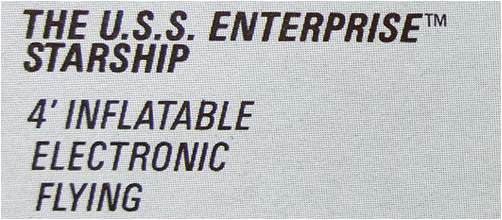TrekCore: The Galoob license was cancelled during the production of the 1989 line of toys, and several planned products never made it to stores. Some were only advertised to retailers, while others actually made it to publicly released cross-sell listings on the action figure backing cards – if things were so shaky when the first-year toys were released, why was a second year of releases planned?
Jim Fong: Toy companies take a big risk every time they release a new product, with no idea if the response will be good or not. We put out the first season of toys, and because it takes about a year to go from concept to production, we have to start on the second season right away – even though the first year’s sales haven’t solidified yet, because if they become red-hot sellers, we’ll have something in the production pipeline to show to retailers.
We basically stopped in the middle of the second year’s production. Consequently, the cancelled toys only survived in bits and pieces, and they never really made it out of the prototype stage.
TrekCore: Well, let’s talk about some of those cancellations. The Next Generation poster produced for the Cheerios contest (and the enclosed insert that came with the mail-away Enterprise) listed a number of different toys that never made it to stores.
Jim Fong: The walkie-talkie set and the FM radios were just “filler” products – in other words, they were standard walkie-talkies and radios, just with the Star Trek logo on the label. They’re simple products, and they give kids a chance to communicate just like an Away Team, but in the end, they were never released.
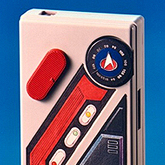 |
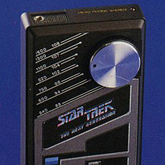 |
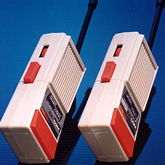 |
| Two FM radios prepared for catalogs; a pair of walkie-talkie units with commbadges. (Photos: Bob DiGiacomo) |
||
TrekCore: What about this ‘electronic’ Enterprise? Playmates eventually put out light-up ship toys with built-in sound chips, but it was a surprise to find out that Galoob had one in the works.
Jim Fong: This is a toy that really nobody knows about – and as far as I know, no other photos exist online. The electronic Enterprise had a grip which you could hold, and it made some flyby sounds while you “flew” the ship around. A prototype model was built, but it didn’t go any further.
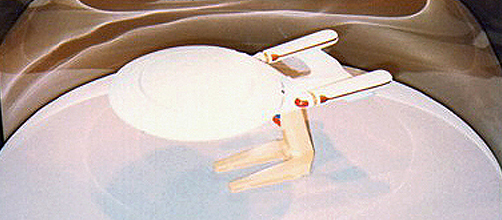 One of the last remaining images of the hand-held electronic Enterprise toy.
One of the last remaining images of the hand-held electronic Enterprise toy.
TrekCore: The ‘flying’ Enterprise has always been an intriguing item. The design is really interesting – a Frisbee-style disc with an attached paper aft section, which trailed behind the disc in flight.
Jim Fong: This one was so odd, and because it was never released, I’m sure that many people don’t know about it. There may still be a few of these out in the wild, but not very many. We obviously cut the steel for it, designed the packaging, and were ready to hit the ‘Go’ button for production, but I don’t really know what happened with this. It’s possible that the time we got to it the whole Trek line was on the decline and they decided not to pursue it any further – that being said, I think the concept is an interesting one and certainly still has potential.
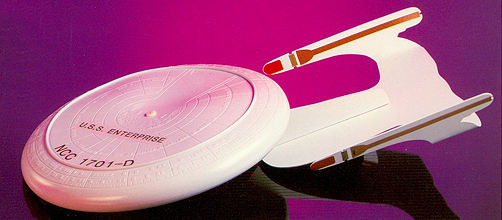 The flying Frisbee-style Enterprise toy. (Photo: Paul Combs)
The flying Frisbee-style Enterprise toy. (Photo: Paul Combs)
TrekCore: We asked one of the senior Star Trek art department staff about this, and were told that it was “one of the coolest prototypes we ever saw… it really did fly pretty well.”
Bob DiGiacomo: You know the expression, “Throw spaghetti against the wall and see what sticks?” Well, the catalogs are just full of different products the general public never hears about; things that were just never produced. You’re always behind the curve in the toy business. You can build prototypes, produce commercials, and cut steel for manufacturing, but if the buyers aren’t interested, all of that work just goes into the trash.
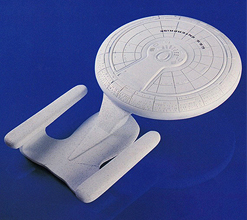 |
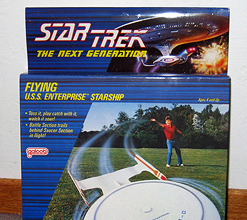 |
| Left: The foam mock-up used in the first sales catalog. Right: The planned retail packaging for the flying Enterprise. (Mock-up: Bob DiGiacomo; Packaging: Jim Fong) |
|
If you look at that initial catalog image for the flying Enterprise, I actually made that mock-up – it’s made out of foam, and if you look closely there’s actually a crack in the model – but the final version wasn’t like that. It was a regular Frisbee disc with a very thin piece of plastic on a pivot that would trail behind it in flight.
TrekCore: We have to ask you about this mysterious ‘inflatable’ Enterprise. It was listed on the Cheerios poster, and then again on the die-cast Enterprise backing card – but even in the 1988 Galoob dealers’ catalog, it was only described in text.
Bob DiGiacomo: I’m not really sure who made that prototype, but it’s possible that it was shopped out to someone over in Hong Kong.
Jim Fong: When you first asked me about this, I had to go double-check that we even made it. It’s not even a toy as we know it, just a big piece of blow-up vinyl – it was just awful, I must have wiped it out of my mind!
I think that it would probably have worked best as like a “swimming pool” Enterprise – you know, something to toss around in the water – but it wasn’t my favorite item. The artwork on the prototype was just done with a marker, but if it had gone into production, we would have done “real” graphics for it to make it look a lot nicer.
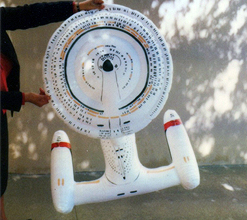 |
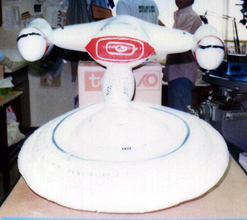 |
| The “awful” inflatable Enterprise prototype, never produced for stores. Bob DiGiacomo can be seen in the background (in striped shirt) in the right photo. (Photos: Bob DiGiacomo) | |
Often times, we tried all sorts of oddball things that don’t end up making it – it made sense conceptually, but once you make a mock-up, it can become pretty clear that it may not be such a good idea after all.
Bob DiGiacomo: You never know what the marketing people were thinking. A lot of times, they were just so frantic to win over a buyer; if they only had sketches, buyers would think that they weren’t serious and wouldn’t be able to deliver the products down the line. They would want to see real commitment – not just an Enterprise toy, but action figures, playsets, and concepts for future products – so the marketing team basically had to spill blood to show buyers they were serious.
TrekCore: What about these paper dioramas (or as they were advertised, the “action environments”)? While they’re artistically impressive, they don’t look too sturdy – is that why they were cancelled?
Jim Fong: Those cardboard dioramas were supposed to be a way to get the products out quickly and inexpensively. Nobody on staff was a paper fabrication and assembly specialist, so we had to outsource it to someone who specialized in that kind of design and construction. In the end, I think that we knew it wasn’t going to be durable enough to handle the stresses of a kid stomping on it.
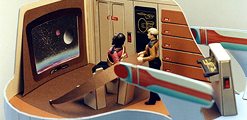 |
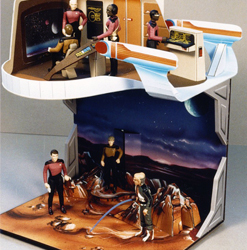 |
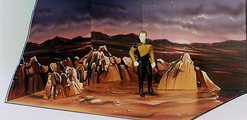 |
|
| The first version of the action environment playsets. (Photos: Jim Fong) |
|
Our first foam-core-and-cardboard mock-up was pretty basic – bridge on top, a planet surface on the bottom – all held together with hot glue. Later, we tried to separate them so they could be sold as independent units to be combined into a larger and more expansive environment.
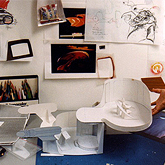 |
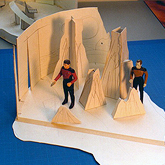 |
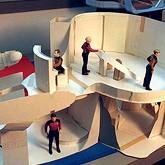 |
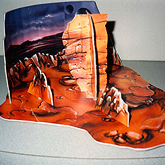 |
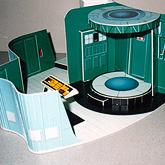 |
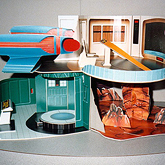 |
| The redesigned action environment playsets, from original sketch to production. (Photos: Jim Fong and Bob DiGiacomo) |
||
The other thing we did was make each diorama a different color scheme, with deep browns on the bridge to evoke the warmth of human interaction, cooler blues of technology on the engine and transporter environments, and hot reds of an alien planet surface.

 Top: The action environments, as advertised in sales catalogs. (Photo: Paul Combs)
Top: The action environments, as advertised in sales catalogs. (Photo: Paul Combs)
Bottom: The only remaining image of the playset retail packaging. (Photo: Bob DiGiacomo)
I remember that one of our in-house designers became very frustrated with them, due to the fact that they had all these tabs – he had a mess of a time lining everything up to fit properly. Personally, I didn’t like it because I wanted a toy made of nice molded plastic to match the lines on the Paramount sets.
TrekCore: Speaking of nice molded plastic, let’s get to what is probably the biggest loss of the ’88 line – that large Enterprise bridge playset. Could you walk us through how that was created?
Jim Fong: Well, actually, that image in the catalog isn’t how it was first designed. My original goal was to have the bridge toy modeled after the actual set; I wanted to replicate the bridge as closely as possible without the usual toyetic distortions. “Toyetic” is an industry term that refers to the normal toy look of a playset, with out-of-scale proportions – here I was aiming for the bridge playset to be a miniature replication of the Paramount set.
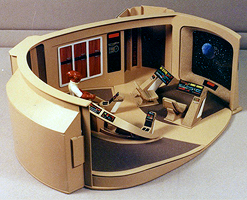 |
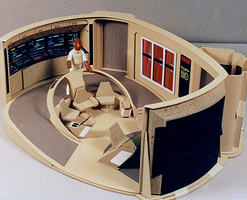 |
| The first configuration of the bridge playset, based on the Paramount set. (Photos: Jim Fong) | |
The initial bridge model received only a lukewarm response. My boss felt that it just wasn’t toyetic enough, so we had to go back and try again, redesigning the bridge to have more toylike proportions and features – so we ended up with this ‘all-in-one’ design putting as many features on the bridge as possible.
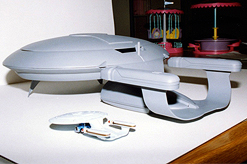 |
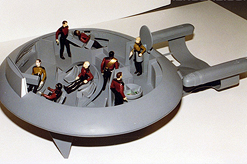 |
| The unpainted prototype of the first molded-plastic ship playset. Note the size of the die-cast Enterprise toy for a size comparison. (Photos: Jim Fong) | |
TrekCore: The first all-plastic prototype may be more toyetic, but all that added detail is wonderful, like the cargo bay area, and having sickbay right there on the bridge!
Jim Fong: I think it’s still strange to have sickbay included on the bridge, but we had to cram all of that stuff in there because we weren’t going to have any more plastic to work with – luckily, we didn’t have to fit an alien planet surface in there as well, because that would have just been too much. I mean, can you imagine having a planet area on the bridge? You’d never have to beam anybody down to fight the aliens!
The advantage of having a pure design is that the proportions are more true to the movie set and it looks better. However, since I’m going for aesthetic authenticity, I was unable to put the transporter feature in there. I can’t remember all the details, but I think my boss wanted a transporter built into the neck of the ship, so we redesigned it again.
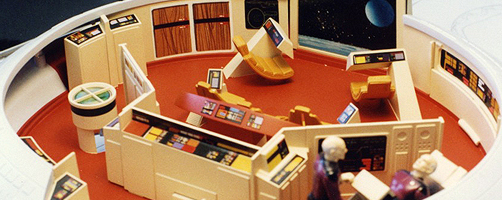 |
|||||
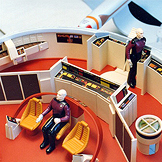 |
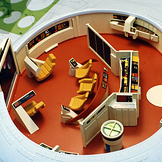 |
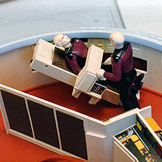 |
|||
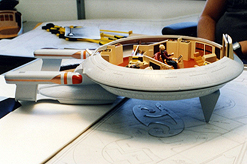 |
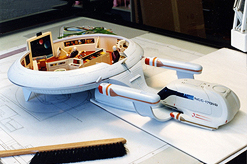 |
||||
| Top: The catalog image and final release of the separable die-cast Enterprise-D. Bottom: Packaging revision notes from Paramount’s licensing department. (Photos: Jim Fong and Bob DiGiacomo) |
|||||
The final iteration of the playset has the added play features, but suffers aesthetically with that cylinder in the neck of the ship. Even today, seeing pictures of that big transporter hump makes me cringe at the styling – but I suppose it’s a trade-off, because it certainly made for better play value as kids could transport on and off of the Enterprise.
TrekCore: Did both versions of the plastic playset separate?
Jim Fong: I think so; Paramount had mentioned to use that the saucer was going to separate from the rest of the ship in the series. It also just made more sense to have the pieces molded separately – it was more manageable for production, and we would have had problems with both manufacturing and expenses if we had tried to mold it as one large piece.
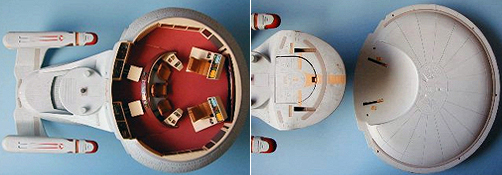 The separable second version of the bridge playset.
The separable second version of the bridge playset.
Since we were going to have to split them up in the molds anyway, it was logical to have the saucer separate as a built-in feature – it was consistent with what we knew of how the ship would function on the show. That hole in the top of the battle section was intended as an easy way to retrieve figures that may have “beamed” off of the ship – you transport them away, and then you just pull them out of the top opening.
TrekCore: So, what happened to it? It seems like it would be the perfect accessory to go with the ten action figures that made it to stores.
Jim Fong: The concept suffered from the same fate as the flying Enterprise – toys and toy lines are usually cancelled due to a lack of interest from retailers, or high production costs. Usually, if the first wave of toys doesn’t meet sales expectations, it’s a bad omen for second year toy line.
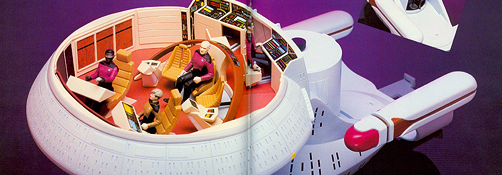 The final design of the bridge playset, as advertised. (Photo: Paul Combs)
The final design of the bridge playset, as advertised. (Photo: Paul Combs)
It’s a real shame, because by the time the second year comes around, toy companies can usually know which characters and toys are more popular than others, allowing us to target production to meet customer interests. For the Next Generation line, it just didn’t work out that way – and I was very sad to see the line dropped.
![]()
< Part I: Launching the Next Generation of Trek Toys · Part III: End of the Line >

